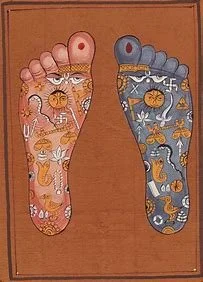INDIAN ANCIENT HISTORY
Vishnu Pada Footprints Buddha’s Footprints
In India, in the Legend of Tirumala, the goddess Lakshmi massages the feet of her consort Vishnu – one of the principal deities, who is a member of the holy trinity of Hinduism along with Brahma and Shiva. It is believed that Vedic physicians followed the practice of massaging the feet for the promotion of relaxation of the body, mind and soul and curing diseases.
The Vishnu Pada Footprints are significant objects connected with episodes in his mythology, so that his feet symbolize the unity of the entire universe. Similarly, the feet of Buddha are transformed into an intricate map of his teachings, which are set symbolically in a many-layered universe. They often bear distinguishing marks, such as a Dharma chakra at the centre of the sole. Both of these are congruent with the belief in reflexology that the feet represent the larger whole.
Footprints of the Buddha abound throughout Asia, dating from various periods. Japanese author Motoji Niwa, who spent years tracking down the footprints in many Asian countries, estimates that he found more than 3,000 such footprints, among them about 300 in Japan and more than 1,000 in Sri Lanka.
Buddhism and Hinduism were the religions of India. Buddhism reached China from India during the Han Dynasty (206BC – 220AD). Silk Road traders probably introduced it to China about 100AD. It is not unreasonable to speculate that reflexology followed this migration of Buddhism with the Buddhist monks.

